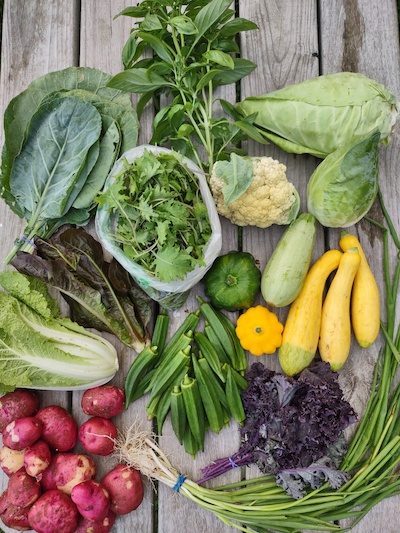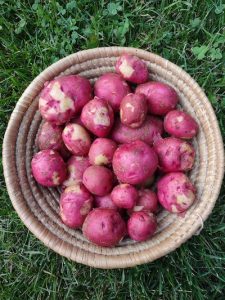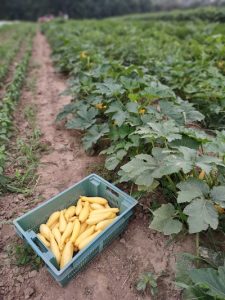
“There can be no leadership when there is no team.”
- New Red Potatoes – All Shares
- Summer Squash – All Shares
- Cone Cabbage – All Shares
- Napa Cabbage – All Shares
- Baby Red Kale – All Shares
- Scallions – All Shares
- Basil – All Shares
- Red Kale – Full & Half Shares
- Cauliflower – Full & Flex Shares
- Okra – Flex Shares
- Red Romaine – Full Shares
- Collard Greens – Full Shares
I heard a segment on MPR this week about how slow the produce season is. “You go to the farmer’s market this year and there are more soaps and crafts than there are vegetables.” We are having a similar experience this year at Earth Dance Farm, so it was a relief to hear that I was not alone. The exceptionally cool May and then the hot and dry June had crops in a holding pattern, and they were also very vulnerable to pests. Here is what we delivered on week 6 last season:
- Summer Squash (All Shares)
- Cucumbers (All Shares)
- Cone Cabbage (All Shares)
- Buttercrunch Lettuce (All Shares)
- Sage (All Shares)
- Swiss Chard (All Shares)
- Snow Peas (All Shares)
- Scallions (Half Shares)
- Green Beans (Full and Single Shares)
- Napa Cabbage (Full and Single Shares)
- Beaver Dam Peppers (Full and Single Shares)
- Eggplant (Full and Single Shares)
- Garlic Scapes (Half Shares)
My cucumbers, green beans, eggplant and peppers are all late this year, and my snow peas did not even germinate in that dry June heat. Our garlic scapes and our potatoes are earlier than last season. Every year is unique and that is part of the beauty of and interest in CSA membership. Our food is dependent on many factors, especially when we do not use chemicals. Having a great variety of crops usually allows us to weather most storms.
~Norm
Crop of the Week: New Red Potatoes
The crop of the week is new red potatoes. Originally from the mountains of Peru, red potatoes can be enjoyed in countless dishes, whether they be the center of your meal or a side. They are lauded for their ability to hold their shape once cooked and absorb flavors. New red potatoes are a good source of fiber, vitamin C, and also provide some iron. If stored in a cool, dark, and dry place they can keep for up to two weeks.
You will notice that some of the new red potatoes have scab. This is a plant disease that most commonly affects root vegetables, including potatoes. When present, the potatoes will develop slightly raised, irregular shaped bumps on their skin. But fear not, once the potatoes are peeled scab is not noticeable and is complete safe to eat.




